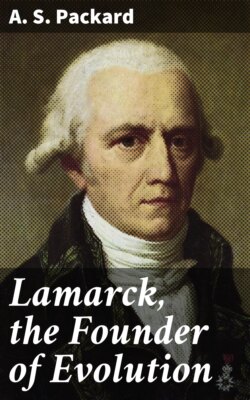Читать книгу Lamarck, the Founder of Evolution - A. S. Packard - Страница 6
На сайте Литреса книга снята с продажи.
FOOTNOTES:
ОглавлениеTable of Contents
[1] In the little chapel next the church lies buried, we were told by M. Duval, a Protestant of the family of de Guillebon, the purchaser (acquéreur) of the château. Whether the estate is now in the hands of his heirs we did not ascertain.
[2] As stated by G. de Mortillet, the date of his birth is variously given. Michaud’s Dictionnaire Biographique gives the date April 1; other authors, April 11; others, the correct one, August 1, 1744. (Lamarck. Par un Groupe de Transformistes, ses Disciples. L’Homme, iv. p. 289, 1887.)
[3] “Sur la maison de Viella—les Mortiers-brévise et les Montalembert en Gascogne—et sur le naturaliste Lamarck.” Par Hippolyte Masson. (Revue de Gascogne, xvii., pp. 141–143, 1876.)
[4] Ibid., p. 194.
[5] A small town in southwestern France, near Lourdes and Pau; it is about eight miles north of Tarbes, in Gascony.
[6] Revue de Gascogne, pp. 264–269, 1876.
[7] The abbé attempts to answer the question as to what place gave origin to the name of Lamarck, and says:
“The author of the history of Béarn considered the cradle of the race to have been the freehold of Marca, parish of Gou (Basses-Pyrénées). A branch of the family established in le Magnoac changed its name of Marca to that of La Marque.” It was M. d’Ossat who gave rise to this change by addressing his letters to M. de Marca (at the time when he was preceptor of his nephew), sometimes under the name of M. Marca, sometimes M. la Marqua, or of M. de la Marca, but more often still under that of M. de la Marque, “with the object, no doubt, of making him a Frenchman” (“dans la vue sans doute de le franciser”). (Vie du Cardinal d’Ossat, tome i., p. 319.)
“To recall their origin, the branch of Magnoac to-day write their name Marque-Marca. If the Marca of the historian belongs to Béarn, the Lamarque of the naturalist, an orthographic name in principle, proceeds from Bigorre, actually chosen (désignée) by Lamarcq, Pontacq, or Lamarque près Béarn. That the Lamarque of the botanist of the royal cabinet distinguished himself from all the Lamarques of Béarn or of Bigorre, which it bears (qu’il gise) to this day in the Hautes-Pyrénées, Canton d’Ossun, we have many proofs: Aast at some distance, Bourcat and Couet all near l’Abbaye Laïque, etc. The village so determined is called in turn Marca, La Marque, Lamarque; names predestined to several destinations; judge then to the mercy of a botanist, Lamarck, La Marck, Delamarque, De Lamarck, who shall determine their number? As to the last, I only explain it by a fantasy of the man who would de-Bigorrize himself in order to Germanize himself in the hope, apparently, that at the first utterance of the name people would believe that he was from the outre Rhin rather than from the borders of Gave or of Adour. Consequently a hundred times more learned and a hundred times more worthy of a professorship in the Museum, where Monet would seem (entrevait) much less than Lamarque.”
It may be added that Béarn was an ancient province of southern France nearly corresponding to the present Department of Basses-Pyrénées. Its capital was Pau.
[8] We have been unable to ascertain the date when young Lamarck entered the seminary. On making inquiries in June, 1899, at the Jesuits’ Seminary in Amiens, one of the faculty, after consultation with the Father Superior, kindly gave us in writing the following information as to the exact date: “The registers of the great seminary were carried away during the French Revolution, and we do not know whither they have been transported, and whether they still exist to-day. Besides, it is very doubtful whether Lamarck resided here, because only ecclesiastics preparing for receiving orders were received in the seminary. Do you not confound the seminary with the ancient college of Rue Poste de Paris, college now destroyed?”
[9] We are following the Éloge of Cuvier almost verbatim, also reproduced in the biographical notice in the Revue biographique de la Société Malacologique de France, said to have been prepared by J. R. Bourguignat.
